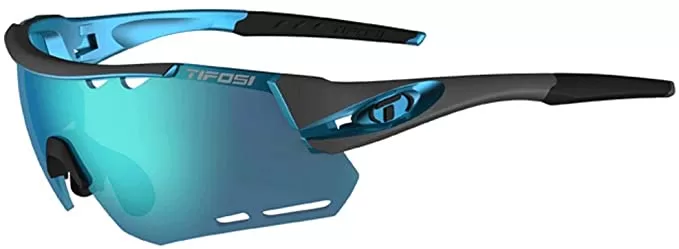When choosing cycling glasses, one key decision is whether to get mirrored or polarized lenses. Both options have pros and cons to consider based on how you plan to use them. As we compare these two popular lens types, keep in mind your planned cycling conditions and priorities.
Cycling glasses serve the important purposes of protecting your eyes from wind, debris, and harmful UV rays. They also improve vision while riding. Two of the most common lens options are mirrored and polarized. Mirrored lenses have a reflective coating, while polarized ones filter out glare.
When deciding between mirrored and polarized lenses, first think about when and where you typically ride. If you’ll use them mostly for mountain biking or riding trails with variable lighting, polarized lenses often work better. For road cycling in consistent sunny conditions, mirrored lenses tend to be a good fit. Cost is another key difference to weigh.
Mirrored Cycling Glasses Lenses
The defining trait of mirrored bike glasses is the partial mirror coating on the outside lens surface. This reflective surface cuts glare and looks stylish. Mirrored lenses come in a range of light transmission levels to match various riding conditions.
The main benefit of mirrored cycling glasses is appearance. The partial mirror finish creates a visible tint that blocks some light. Going with mirrored lenses when cycling glasses cost so much mainly comes down to aesthetics. Beyond looks, they effectively reduce glare and let you cycle comfortably on sunny days.
One downside is that the tint level stays the same regardless of conditions. Photochromic mirrored lenses that react to UV rays offer one solution. Still, even adaptive mirrored lenses can’t darken as much as some polarized options. So they may not provide enough glare protection for mountain biking.
Polarized Cycling Glasses Lenses
Rather than using a mirrored coating, polarized lenses include a special filter integrated into the lens material. This vertically oriented filter blocks intense reflected light waves, known as glare. The result is improved clarity and contrast for defining terrain and spotting obstacles.
If seeing clearly while cycling is a priority, polarized lenses have some advantages. They cut through glare better than mirrored lenses in variable conditions with sunlight and shade. Many models also achieve a darker tint when needed.
One potential polarized sunglasses drawback is they may not be ideal for road cycling. Since they filter light vertically, that can obscure LCD cycling computer screens. So riders who train mainly on paved roads may want to consider photochromic mirrored glasses instead.
Comparing Mirrored and Polarized Lenses
Now that we’ve covered the basics of each lens type, let’s directly compare mirrored and polarized cycling glasses. Keep these key factors in mind as you choose which option may work better for your riding needs.
Glare Reduction
Polarized lenses tend to block glare more effectively overall. Their specialized filters are better suited to variable mountain biking conditions with shade and sun patches. Mirrored coatings also cut glare, but can’t adapt their tint levels like photochromic polarized lenses.
Versatility & Adaptability
If you ride trails one day and paved roads the next, polarized photochromic lenses offer maximum versatility. They react quicker to light changes better than adaptive mirrored lenses. For consist sunny road cycling, mirrored sunglasses provide reliable protection.
Clarity
Seeing bumps and rocks clearly matters most on rugged mountain bike trails. Polarized glasses enhance clarity by filtering out intense reflected light. So they make it easier to read terrain details. Mirrored lenses also improve vision, but not to the same degree as polarized options.
Appearance & Style
When it comes to looks, mirrored cycling sunglasses are hard to beat. Even cheap options under $40 can look great thanks to stylish reflective lens coatings. Polarized lenses prioritize function over flashy appearance. But some newer models combine polarization with more subtle mirror finishes.
LCD Screen Visibility
Riders who use cycling computers may prefer mirrored over polarized lenses. Since polarized glasses filter light vertically, they can obscure LCD screens. Mirrored lenses don’t have this polarization side effect. However, some bike computers work fine with polarized sunglasses, so test this out if possible.
Lens Tint & Color
Yellow and amber tints are common color options for both lens types to enhance terrain contrast. Polarized lenses also come in gray options. Mirror coatings add a visible reflective tint, often in grayish-green, blue, gold, or red shades. Some riders feel colored lenses like yellow bike glasses improve depth perception and definition.
Durability & Care
Mirrored coatings do wear over time with lens scratches and damage, sometimes revealing the base tint underneath. Both lens types require proper storage and cleaning to prevent scratches. Polarized lenses tend to be more expensive to replace. So take extra care not to drop or scrape your polarized cycling glasses.
UV Protection
Nearly all quality cycling sunglasses, including affordable options, block 100% of UV rays with UVA and UVB protection. So both mirrored and polarized lenses are equal when it comes to screening out ultraviolet light and supporting eye health.
Night Riding Capability
For mountain biking after dark, you’ll want clear cycling glasses. But photochromic polarized lenses offer some versatility to adapt from day to early evening rides. Due to their darker tints, mirrored lenses tend to be less suitable for use at night.
Which is Better for Mountain Biking?
Mountain bikers contend with constantly changing trail conditions going from sunlight to tree shade. The variable lighting makes polarized lenses often the best choice over mirrored ones. Top MTB glasses brands like Oakley sell specific models with hydrophobic polarization technology to repel dirt and water.
Photochromic polarized lenses are especially versatile for mountain biking. They react faster than mirrored adaptive lenses to lighten and darken when hitting sunlight gaps and shade spots. This helps maintain vision clarity when illumination varies widely along rocky trails.
While some pricier mirrored cycling glasses work well off-road, polarization remains the gold standard. The specialized glare-cutting filters define terrain contours better to spot rocks and roots. Durable construction also matters since crashes and drops are more likely mountain biking than road riding.
So when comparing options specifically for trail and enduro riding, polarized lenses tend to provide better vision and durability. They also handle shifts between bright and shaded sections smoother. Adaptive polarized MTB glasses meet the needs of most mountain bikers across a wide range of fast changing conditions.
Making the Best Choice for You
Now that you know the pros and cons of mirrored and polarized cycling glasses, think about when and how you ride most. Prioritize lens features that align with your typical riding style and needs. Mountain bikers benefit more from enhanced clarity and contrast of polarized lenses. Road cyclists may favor the stylish appearance of mirrored glasses.
Also realistically weigh your budget constraints. Adjust expectations for inexpensive glasses versus high-end brands when it comes to performance and build quality. With so many models on the market, you can likely find both mirrored and polarized cycling sunglasses to meet your needs at a reasonable price.
Focus on frames that fit your face shape and feel comfortable once adjusted. It’s worth trying on different glasses brands in person to test the fit. Properly aligned lenses and nose pads prevent annoying bouncing. Secure ear hooks keep your cycling shades locked in position when riding fast over rough terrain.
Once you select the right mix of lens technology, comfort, and affordability, the choice between mirrored or polarized lenses for your cycling glasses becomes much simpler. Protect your eyes and see the road or trail ahead clearly as you balance performance, appearance, and value. With a bit of comparison shopping, you’ll enjoy the benefits of versatile modern sunglasses engineered for cycling’s unique demands.






